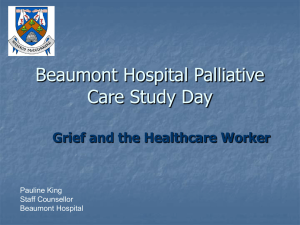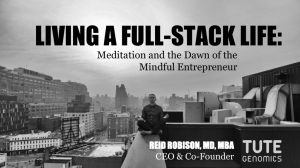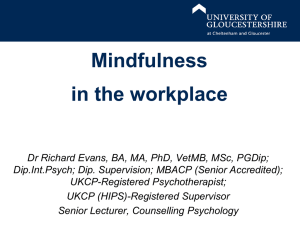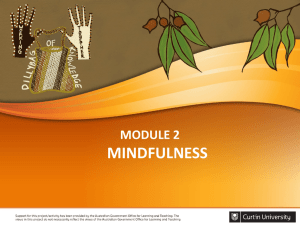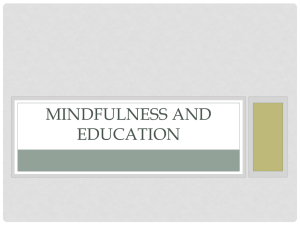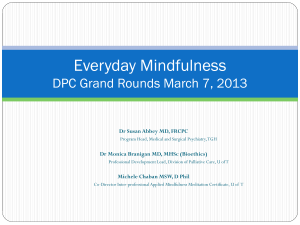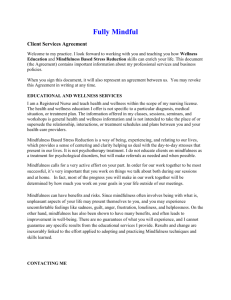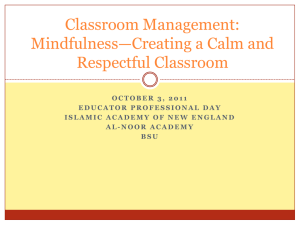Mindfulness Practice
advertisement
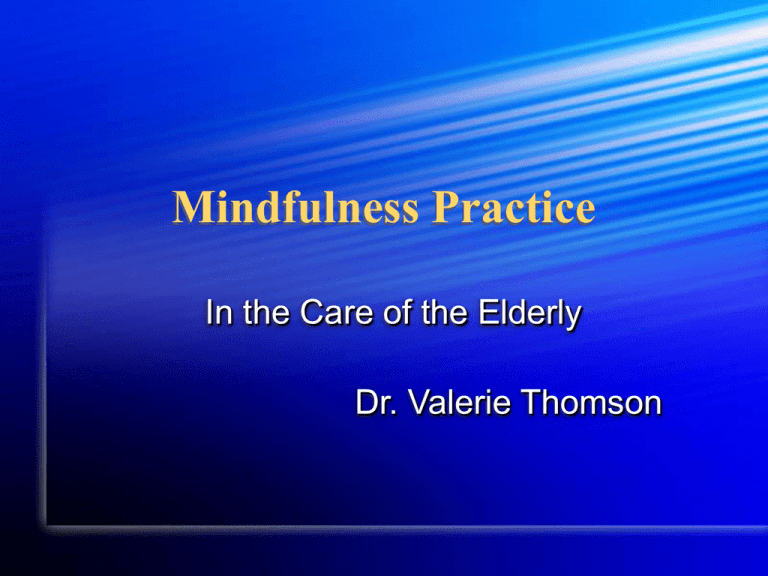
Mindfulness Practice In the Care of the Elderly Dr. Valerie Thomson Cultural Influences Aging remains one of the last “taboos” Cultural images are designed to make us feel that aging is a sign of “failure” This attitude creates great pain and suffering as we pit ourselves against the inexorable process- developing signs of aging - crow’s feet, stretch marks, age spots - and our attempts at denial with facial creams, hair colour, cosmetic surgery In a material culture, the outer world is of primary importance Cultural Influences The aging individual is seen as “something less” than when young, instead of something more Aging can be transformed into a process of developing wisdom, a cultivation of our ability to know ourselves as whole human beings With mindfulness practice while getting older we learn we are more than our bodies and minds Practice can help develop a welcome distance between who we are and the suffering we experience at the level of body and mind Cultural Influences Attitudes toward elder care are heavily influenced by cultural norms Our ability to care for the elderly is also dependent on our fear of growing old ourselves - our personal experiences of loneliness, embarrassment, powerlessness, loss of role and meaning Learning to Become Mindful In learning to become mindful, to age consciously and without fear we must be willing to face the truth of our own lives - the content of our minds, our own suffering and the suffering around us, without averting our gaze, and allow it to “be” in the present moment. From : Still Here, by Ram Dass What Is Mindfulness? The practice of being fully present, “in the moment” A way to stop dwelling on the past or worrying about the future An opportunity to fully experience our lives A process of becoming fully conscious A way of “being” rather than a technique The Mindful Process Formal Practices Disciplined - meditation Awareness of the breath, awareness of the body (Body Scan), Exercise (Yoga, Tai Chi) Informal Practices Being in the moment - eating, walking, washing dishes Using cues and reminders to be mindful Mindfulness Practices Maintaining attention through the day, often during routine activity Learning to focus, concentrate and calm the mind and body Looking deeply at ourselves and the way we do things, understanding ourselves better Seeing clearly we can make good choices for ourselves, change old habits Mindfulness at Work Bringing our whole self to the job Listen without calculating or analyzing our next move Allows for an authentic and meaningful response, rather than a “pre-programmed package” Mindfulness at Work Observe your own thoughts, feelings and body sensations Use this as information, allowing you to understand the causes and conditions of your own reactivity Mindfulness at Work Calm your mind and body Using the breath as an anchor to the present moment The 3 Minute Breathing Space Awareness/Gathering/Expanding The Fruits of Practice Mindfulness - cultivating good health, both physical and mental Meditation - cultivating a calm, clear mind and the ability to look deeply Understanding - clear perception destroys illusions and insight is possible Patience - using the breath to slow things down and let the day unfold Ways to Reduce Workday Stress Take a few minutes in the morning to sit quietly, meditate or take a slow quiet walk Pay attention to your breathing when you start up the car Become aware of body tension while driving. Consciously practice releasing and dissolving the tension Decide not to play the radio, be with yourself Go the speed limit Ways to Reduce Workday Stress Pay attention to your breathing or the scenery around you when stopped at a red light Take a moment to orient yourself to the workplace once you park the car While performing your duties monitor bodily sensation - consciously letting go of excess tension Use your breaks to truly relax - take a 2-5 minute walk or sit at a desk and recoup Change your environment at lunch or try closing your door if you have one Ways to Reduce Workday Stress Stop for 1-3 minutes every hour, becoming aware of your breathing and your bodily sensations Use cues as reminders to centre yourself (ringing phones or call bells) Share some time with close associates at lunch. Choose topics unrelated to work Eat one or two lunches a week in silence At the end of the day, retrace your steps, acknowledge your accomplishments Ways to Reduce Workplace Stress Pay attention as you walk to your car - breathing the air. Can you walk without feeling rushed? Sit quietly when you first get in your car and consciously make the transition from work to home While driving, notice if you are rushing. What does this feel like? What can you do about it? When you pull into the driveway take a moment to come back to the present. Orient yourself to being with family. Change out of work clothes, moving into your next “role” Adapted From: Saki Santorelli, Tips and Reminders for Being Mindful During the Workday Practice Resources Full Catastrophe Living by Jon Kabat-Zinn Mindfulness-Based Cognitive Therapy for Depression by Segal, Williams and Teasdale The Wellness Book by Herbert Benson Still Here by Ram Dass Coming to our Senses by Jon Kabat-Zinn The Miracle of Mindfulness by Thich Nhat Hahn Guided Mindfulness Meditation Practice CD’s by Jon Kabat Zinn: www.mindfulnesscds.com
